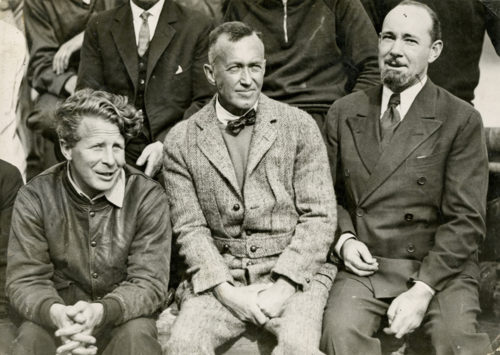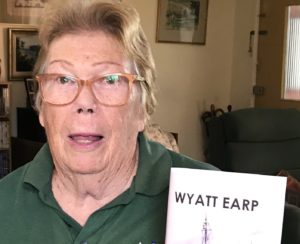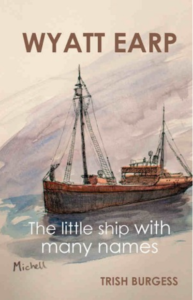
THERE’S something counterintuitive about a book on an Antarctic ship named “Wyatt Earp” coming out of landlocked Canberra, but when author Trish Burgess explains her background, it makes sense.
Burgess is no stranger to publishing. A long-time administrator at UNSW Canberra and now volunteer researcher, editor and proof-reader in the Howard Library, she is also a former vigneron who co-authored “Riesling in Australia” with Ken Helm.
But a book about the Antarctic? It turns out that Burgess, a Canberran since the 1960s, is the descendent of a naval family.

Her grandfather was manager of Williamstown Dockyard in Melbourne, from which the British research ship “Discovery” set out in 1935 to find the American polar explorer Lincoln Ellsworth, who had gone missing in the Ross Sea. Burgess’ mother had met a young naval officer on the search ship who wrote to her for several years, sending details of the actual finding of Ellsworth.
Burgess helped her mother self-publish the letters from the young officer and it was the beginning of a lifelong infatuation with the Antarctic, culminating in a new book, “Wyatt Earp: The Little Ship With Many Names”, published this month.
The larger-than life Ellsworth flew 3500km across the Antarctic mainland in 1935 and his four Antarctic expeditions opened up Australian people’s thinking about the Antarctic, she says, but the impetus to tell the story in book form came with the commemoration in September 2019 by the Australian Antarctic Division and the Norwegian Ambassador of the 100th anniversary since the launch of a little wooden ship built in 1919 in Molde, Norway.
Initially named “M/S [Motorskip] Fanefjord”, she (you can tell Burgess is from a naval family by her casual use of the female personal pronoun) was built as a coastal trading ship to carry cargo from Norway to England and as far north as Greenland.
An ordinary enough start, but from there the modest craft enjoyed an adventurous life coloured by the personalities who steered her.
It helped that Burgess’ scientist husband spent 11 summers in 16 years in the Larsemann Hills, near Davis Station in the Antarctic. His daughter, Canberra-born artist Matilda Michell, who won the Waterhouse Natural History Art Prize in 2009, would go on to create the cover imagery for the book.
Following her husband’s retirement, Burgess made four small ship expeditions to the Antarctic, leading to a fever of researching and writing on the history of the region.
The story of Lincoln Ellsworth and his quaintly-named ship piqued her curiosity.
“Lots of people know a little bit about the ‘Wyatt Earp’, but nobody knows it all,” Burgess tells us.
She saw the material she uncovered as “an opportunity to bring real stories to life. She [the ship] had eight different names and there’s been a lot of misinformation about her over the years… but I had to keep reminding myself that it was the story of the ship, not of Lincoln Ellsworth”.
Not easy. Ellsworth Land, Mount Ellsworth and Lake Ellsworth in Antarctica were all named for Ellsworth, but the ship was her focus and connection began in 1933, The Australian Arctic and Antarctic explorer Sir Hubert Wilkins, had found M/S Fanefjord as a suitable vessel on behalf of the wealthy American, who had plans for Antarctic voyages and aviation feats.
 The eccentric Ellsworth, who claimed to own the hair-trigger six-shooter with which the ‘Gunfight at the O.K. Corral’ hero had fought, quickly renamed the ship the “M/V [Motor Vessel] Wyatt Earp”.
The eccentric Ellsworth, who claimed to own the hair-trigger six-shooter with which the ‘Gunfight at the O.K. Corral’ hero had fought, quickly renamed the ship the “M/V [Motor Vessel] Wyatt Earp”.
“After the famous frontier marshal of the West… one of my whims was to imbue the whole enterprise with the spirit of Wyatt Earp, the bravest man I ever heard of,” he said.
During her adventurous life to come, the boat would have eight variations of name.
“She” was to make five trips to the Antarctic, four with Ellsworth and Wilkins between 1933 and 1939 and one for the newly-formed Australian National Antarctic Research Expedition in 1948-1949.
Burgess’ book covers her early years, her four Antarctic voyages between 1933 and 1939, her sale to the Australian government and her wartime duties with the Department of Defence and the Royal Australian Navy, a time when she was lent to the South Australian Boy Scouts, commissioning for the first Australian National Antarctic Research Expedition, her life as a coastal steamer carrying explosives to WA and Papua, and her final days carrying cargo to Fiji, Papua New Guinea, Lord Howe Island and along the east coast from Tasmania to Cairns.
Although a new “Wyatt Earp” joined the Australian Hydrographic Service in 1993, the old one is no more.
In January 1959, on a dark and stormy night at Rainbow Beach near Fraser Island, the ship grounded, never to sail again.
“A warm and sunny place for the ‘Wyatt Earp’ to rest, Burgess says.
“Wyatt Earp: The Little Ship With Many Names”, $29.95. connorcourtpublishing.com.au
Who can be trusted?
In a world of spin and confusion, there’s never been a more important time to support independent journalism in Canberra.
If you trust our work online and want to enforce the power of independent voices, I invite you to make a small contribution.
Every dollar of support is invested back into our journalism to help keep citynews.com.au strong and free.
Thank you,
Ian Meikle, editor




Leave a Reply